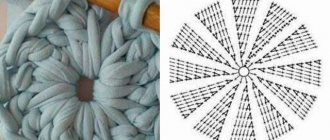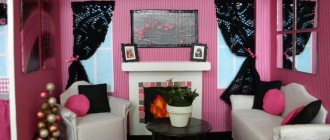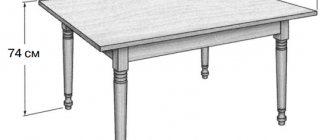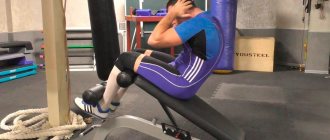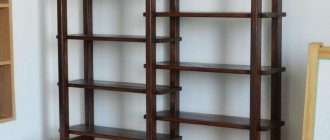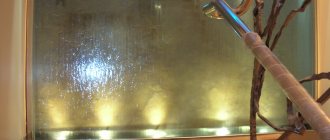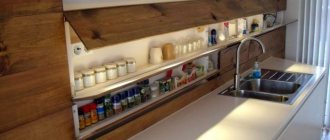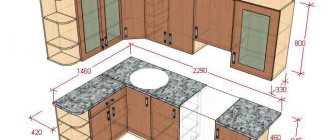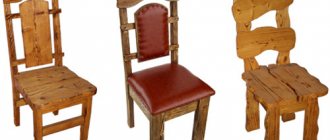Among athletes who engage in strength training, the most popular is the bench press. Thanks to this simulator, you can pump and strengthen muscle groups located in the chest and triceps area. However, not everyone has the opportunity and time to visit the gym, so some craftsmen make this equipment themselves. The design of a do-it-yourself bench press is no different from standard factory-made models. All you need to make it is a small number of tools and materials.
Design modifications
Bench benches are divided into two types: horizontal and adjustable. They differ both visually and functionally. A horizontal bench press with four fixed supports is the simplest basic design. It only implies the user's supine position during training. Such sports equipment is low-functional and is mainly suitable for working the pectoral muscles, as well as the front deltoids.
In a three-post design, two posts are used to mount various equipment and barbell petals. Most often it is equipped with the following sports equipment:
- leg block – designed for performing exercises on the thighs, calves, buttocks, as well as crunches to work the abs;
- additional handrails – will allow you to effectively train your lower abs;
- retractable racks – make it possible to perform exercises with a barbell without additional insurance.
- parallel bars - for push-ups.
These and other devices significantly expand the functionality of the horizontal bench.
Another type of sports equipment for bench presses is an adjustable bench. In it, the lounger (back) can be adjusted in height. The package includes racks with various accessories: brackets, stoppers, clamps. Exercises on such a bench can be carried out both sitting and lying down, using equipment for dumbbells and barbells. With this machine you can perform bench presses at different angles, pumping up many muscle groups. This adjustable bench is most convenient for installation in an apartment and does not require the use of other exercise equipment, as it performs many functions.
A simple horizontal design is quite easy to make. However, if you want to independently supplement such a bench with the devices described above and an adjustable lounger, it will require much more effort and skill.
Horizontal on four fixed supports
With three supports
Adjustable
Buy or make it yourself
I often welcome home-made exercise equipment, especially where you can save money without losing quality. For example, making a jumping stand, a step platform and other exercise equipment. But with the athletic bench things are completely different. You must understand that this is not just a structure for holding a barbell - it is a machine that ensures the safety of the press. Nothing should be loose in it, and the maximum permissible load on the fasteners should be many times greater than the actual weight of the athlete.
Just imagine what the consequences could be if a leg or a lounger breaks under an athlete and a frame with a barbell falls on him. And if at the same time you squeeze out an impressive weight? That’s why I always insist that a sports bench is not a piece of equipment you need to skimp on.
If you have limited finances, especially if you are equipping a home gym, it is better to choose budget models. They feature cheaper materials but still provide a robust design. Moreover, making a good simulator on your own will require a lot of effort and expense: metal profiles, clamps, welding, etc. In this case, the choice is obvious: it is better not to take risks, but to use ready-made factory models.
Varieties
Do-it-yourself bench presses can be made in two versions:
- all-welded construction;
- dismountable with bolts.
Each of them has its own advantages and disadvantages. An all-welded bench is a monoblock that is manufactured by welding parts. Its main advantages are stability and reliability, since the fastening method used will not allow the seams to come apart even under heavy loads. Such a horizontal design is bulky, its installation is impossible in small rooms, which is especially important in a small apartment. Its functionality is also low, since it does not allow the use of additional devices. This power bench is structurally simple, which makes it durable. It is not difficult to make it if you have the skills to work with a welding machine.
A collapsible transforming bench is the best installation option in the house. It is compact and does not take up much space. Its functionality is higher than that of a candy bar. If you add it with an adjustable backrest, you get an inclined bench. This will allow you to perform a variety of exercises on the muscle groups of the legs, arms, shoulders and buttocks, which provides a comprehensive development of the entire muscle mass of the human body. It can be installed and disassembled in a matter of minutes. Assembling a transformer requires skill in using various tools, such as an angle grinder, a drill and others. It is more difficult to manufacture than an all-welded model.
Dismountable with bolts
All-welded construction
Kinds
Universal bench press
Bench benches are:
- Universal (multifunctional). A universal bench press is complemented by a number of additional options: a device for pumping quadriceps, a butterfly machine, a Scott bench, and sometimes even a block system for performing rows or crossovers. It is well suited for fans of some combination sets and supersets for antagonist muscles, because... no long pauses are required to switch to another simulator.
- Horizontal. The horizontal bench is designed to perform a standard bench press. Benches 60 cm wide are considered narrow.
- With fixed or adjustable positive angle. Benches with adjustable inclination angles allow you to shift the load vector using appropriate types of exercises. Fixed incline benches do not have the ability to change the incline angle.
- With a reverse slope. Reverse incline benches are designed for performing head down presses at an angle of 30-45 degrees.
- For the seated press. In seated press benches, the position of the backrest is close to vertical.
- Mobile. Mobile benches are not paired with racks and can be used with racks not intended directly for bench presses.
Materials and tools
The main material of the bench frame for a do-it-yourself bench press is a professional pipe measuring 4 x 4 cm. You need to take a profile with walls no thinner than 2 mm. For petal holders under the bar, you need a strip of steel at least 4 cm wide and 5 cm thick.
In order for the frame to withstand heavy weight, the material must be particularly strong.
To assemble the sunbed you will need the following materials:
- steel sheets 2 mm thick;
- polished board;
- foam rubber 2 cm thick;
- durable textiles with water-repellent impregnation or leatherette;
- universal glue.
The fastenings are bolts and nuts, as well as a door hinge that attaches the adjustable lounger to the base. To make a bench you will need the following tools:
- vice;
- knife;
- drill;
- stapler;
- welding machine;
- Bulgarian.
Profiled pipe
Steel sheets
Sanded board
Foam rubber
Upholstery fabric
Tools for work
Measurement of design parameters will be carried out with a tape measure. If you have the skills to work with the above tools, then making a bench press bench with your own hands will not be difficult. In addition to the profile, the frame can be assembled from wooden parts. Materials that will be required to assemble such a structure:
- wooden blocks of three sizes: 2.5 x 5 x 9, 5 x 5 x 25, 10 x 10 x 250 cm;
- plywood panel measuring 30 x 2 x 120 cm;
- bolts and nuts (M5 x 200 mm; M4 x 80 mm; M5 x 300 mm) – 4 pieces;
- nylon washers M5 – 8 pieces, body washers M5 – 14 pieces;
- self-tapping screws 80 mm – 4 pieces;
- rubber pad for racks.
For finishing, you will need impregnation that increases moisture resistance, and varnish for painting the finished bench. To make your homemade structure more durable, you can use glue along with the fasteners. Necessary tools when assembling the product:
- circular apparatus;
- saw or jigsaw;
- chisel;
- spanners;
- drill;
If you choose unsanded wooden blocks, you will need a sanding machine.
Wood is an environmentally friendly material, but not durable enough. In terms of stability, it is significantly inferior to the profile, since it is much lighter. The service life of a structure made of wooden bars is limited, so it would be more advisable to use metal ones - they are more functional.
Wooden blocks
Plywood board
Fastenings
Finishing agents
Assembly tools
SPECIFICATIONS:
a). The neck must be straight, have good checkering or cutting and meet the following measurements:
i.
The total length of the bar should not exceed 2.2m, with the exception of a specialized bar for squats.
ii.
The distance between the surfaces of the neck bushings should not exceed 1.32m and should not be less than 1.31m.
iii.
The diameter of the bar should not exceed 29mm and should not be less than 28mm, with the exception of a specialized squat bar.
iv.
The weight of the bar with locks should be 25 kg.
The weight of a specialized bar for squats with locks should be 30 kg. v.
The diameter of the neck end sleeve should not exceed 52mm, and should not be less than 49.5mm.
vi.
The fingerboard should have circular notches, the distance between which should be 81cm.
vii.
The diameter of a specialized bar for squats should not exceed 32mm; the length of the bar end bushings for putting on discs should not exceed 508mm; the distance between the surfaces of the neck bushings should not exceed 1434 mm; The total length of the neck should not exceed 2400mm.
b). Disks must meet the following requirements:
i.
The difference between the marking weight of the disc used in competitions and its actual weight must not be more than 0.25% of its marking weight.
ii.
The diameter of the hole in the center of the disc should match the diameter of the bar so that unnecessary movement is eliminated.
iii.
Discs of 1.25kg, 2.5kg, 5kg, 10kg, 15kg, 20kg, 25kg, 45kg and 50kg should be used.
For record purposes, 0.5 and 0.25 kg discs can be used. iv.
For record purposes, lighter discs can be used, which allow the weight to be increased by at least 500g compared to the previous record.
v.
All discs must be clearly marked with weight and must be installed on the bar in the following order: heavy discs on the inside (closer to the center of the bar), and smaller discs in descending order on the outside.
vi.
The very first and heaviest discs should be installed on the bar with their faces facing inwards, and the remaining discs – with their faces facing outwards.
vii.
The diameter of the heaviest discs should not exceed 45cm.
viii.
It is desirable that the color discs meet the following requirements: discs of 10 kg and less - any color, 15 kg - yellow, 20 kg - blue, 25 kg - red, 45 kg - golden, 50 kg - green.
c). LOCKS
i.
Must be used in competitions.
ii.
Must weigh 2.5 kg each, unless using a dedicated squat bar. Locks designed exclusively for a specialized squat bar should only be used on that specialized bar.
Dimensions
The standard bench press dimensions are as follows:
- support length – from 97 to 122 cm;
- the height of the stand in the front of the bench is 83 cm;
- rear stand height – 34 cm;
- width between the front pillars – 52 cm;
- the length of the stands for the front supports is 22 cm, for the rear ones – 30 cm;
- the length of the lounger (in the design of the adjustable bench) in the front part is 94 cm, in the rear part – 16 cm;
- the length of the inclined structure lounger is 20 cm longer than the horizontal one;
- The width of the bench for bench press is from 29 to 32 cm.
The height of the structure above the floor level is determined by the size of the lower arm of the leg lever. To be safe, it is advisable to leave a margin of about 10 centimeters. To choose the optimal length, you need to take into account the athlete’s height.
Dimensions vary based on the area of the room where the exercise machine will be located, as well as the athlete’s build. But for ease of use, making the bench narrower than standard sizes is not recommended. The width of the lounger should not be less than generally accepted standards, since this parameter affects the work of the muscles and, ultimately, the result of the workout.
SQUAT RACK
a).
A squat rack should be of sturdy construction and provide maximum stability.
The base of the stand must be designed in such a way that it does not interfere with the athlete and spotters/assistants. The rack can be a one-piece structure, or consist of two separate racks, which are designed to hold the bar in a horizontal position. b).
The squat rack should be designed so that the height of the rack can be adjusted to suit the height of the athletes.
c).
The height of the rack must be adjusted in increments not exceeding 5 cm.
d).
All hydraulic struts must be able to be fixed to the desired height using insertable couplings.
e).
All World Championships and National competitions must use an adjustable hydraulic squat rack or a non-traditional squat rack known as a "Monolift".
Create a drawing
The manufacture of any bench press model begins with the completion of a drawing. The figure should indicate all the design features of the future simulator and its dimensions. You can find a ready-made scheme on specialized resources, where all the nuances are described in detail. However, in this case, you need to take into account that the proposed dimensions may not coincide with those that are necessary. To achieve the desired result, you simply need to replace the original parameters. If you have experience training on a professional bench press in the gym and performing exercises on it effectively, then you can take the dimensions of this apparatus and make drawings based on them yourself.
Recommendations for training
- Train no more often than every 1-2 days. This will be enough for full muscle recovery.
- If the goal is to gain mass, perform all exercises with such weights that a set cannot be completed more than 12 repetitions. To begin with, 3 approaches are enough, over time their number can be increased to 4.
- To maintain muscle tone or relief, as well as lose weight, perform the complex for 15-20 repetitions of 3-4 approaches.
Step-by-step production of an inclined bench from profile pipes
In order to independently assemble an inclined sports bench for bench press with three supports at home, you need to prepare the materials and tools described above. Making a bench takes place in two stages: constructing the frame and the deck chair. Before starting work, it is worth practicing the skills in using the necessary tools.
Frame
Algorithm for assembling a metal frame:
- Two 83 cm long sections are cut from the pipe, which will serve as frame racks, as well as support for the rod.
- At a distance of 34 cm from the bottom edge of the rack, a mark is placed that indicates the location of the connection of the elements with the next part.
- The third part of the profile, 52 cm long, is cut off, which will connect the legs, and the fourth part, 34 cm long, is cut for the stand on the opposite side of the bench, at the legs.
- To connect the front and rear legs of the bench, an element 97 cm long is cut off - this will be the support. It is welded to the rear pillar from above, while to the front pillar - from the side. Self-tapping screws can be used to connect parts.
- Specially prepared petals are attached to the profile pipe-racks on top or on the side. They are made from strips of steel that are bent into a "J" shape with a vice. The long side of this part should be 7 cm, and the short side should be 2-3 cm.
- Holes with a diameter of 1 cm are drilled to the crossbar connecting the front pillars. They are necessary for attaching reinforcing rods 30 cm long that regulate the height of the lounger.
In order not to spoil the floor covering by the racks pressing into it, special devices are installed on them - expanders. The connection is also made by welding.
Cut pipes to the required size
Mark the joints of the parts
Cut support
Weld the support to the rear pillar from above, to the front pillar - from the side
Attach prepared petals from steel strips to the posts
Sun lounger
The adjustable workout bench design's bed should consist of two parts that are different in size. Assembly algorithm:
- The short sheet is fixed in the legs, and it should protrude 5-10 cm beyond the end of the stand.
- A long sheet is installed at the head of the bench. It is attached with a door hinge, then welded to the frame and to the base of the lounger.
- Reinforced rods are attached to the underside of a larger steel sheet at a distance of 10 cm from the edge. Their purpose is to raise the lounger to train different types of muscles.
- A sanded board is attached to the steel sheets, the width of which should exceed the size of the first by 5 mm. The connection of two elements is made with self-tapping screws. At the junction of metal sheets, the wooden board should be 1 cm shorter on both sides.
Using universal glue, foam rubber is fixed to the prepared board. It must be pre-measured, leaving 5 cm for allowance. The lounger is covered with thick fabric using a construction stapler.
Cut corners and drill holes to attach the board
Weld the fasteners to the support in three places
Install the sunbed using self-tapping screws
Connections
The parts of the bench frame for the home are connected by welding. Small parts are attached using bolts and nuts. The joints between wood and metal are also fixed with self-tapping screws, which should not come out of the structure. Welding work to connect parts must be carried out with special care so that the seams do not come apart under high loads and vibrations.
Attach the seat to a metal piece
Install the backrest and lounger
Screw on the adjustment foot
Finished bench
Performing a bench press
After an assistant has helped you lift the barbell from the racks before starting the set, pause while holding the barbell above your chest with your arms outstretched to stop the barbell from swinging. Now retract your shoulder blades, i.e. try to squeeze them together, and immediately lower the bar while maintaining control over it. The descent should take approximately two seconds. The way you lower the bar will greatly influence the position from which you start lifting it.
Lower the bar to a point that is below the nipple line, i.e. to the lower edge of your pectoral muscles. Typically, this means that you will have to lower the barbell lower on your chest than you were previously doing. Determine exactly the point on your chest to which it is most convenient for you to lower the barbell. As noted above, when the bar is on your chest, your forearms should be vertical when looking at them like
from the side
and
from the front (or from behind, depending on where the observer is located). If your forearms are not vertical, then you are gripping the bar incorrectly.
Never perform a push press from your chest or from the rack restraints. Either simply touch the bar to your chest and then immediately press the bar up, or pause very briefly on your chest (or on the bars if you're pressing from the bottom of the rack) before pressing the bar back up. Either way, squeeze, tense your muscles, open your lats, and press the barbell upward powerfully.
In the figure below you can see approximate options for the trajectory of the barbell when lifting it in the bench press (the head is on the right). Both options assume that you have lowered the bar correctly to a point at or very close to the bottom edge of your pecs, and that your elbows are directly below your wrists. Experiment with both options or even find something in between and settle on what suits you best.
The first few centimeters of the rise should be vertical, or almost vertical. The only direction in which your barbell definitely should not
move is in the direction of the legs!
To ensure that the bar does not move even a millimeter towards your legs, raise its top, but not strictly horizontally, but slightly
towards your face.
Two options for moving the bar while lifting the barbell in the bench press. Your head is on the right. See text.
Take a video of yourself or ask someone to watch you from the side. What may seem like an initial vertical movement to you may actually be a subtle movement towards the feet. You may think that you are moving the bar slightly towards your face, but in fact you are raising the bar exactly vertical. Observing yourself from the outside will help you find out with complete certainty how you lift the barbell. Then, through trial and error, you can find exactly the trajectory for the first few centimeters that suits you best.
The rest of the upward amplitude can be passed in several ways. First, continue pressing the barbell in a straight line as you did during the first phase described above. This way, the bar will move almost vertically from the line of your lower pecs with only a subtle drift towards the head. The second option for the remainder of the amplitude, following the first phase described above, involves moving the bar towards your collarbones in a steep diagonal line, which then passes into the final, almost vertical phase either over your upper chest, or, in extreme cases, over your collarbones . Keep your forearms as perpendicular to the floor as possible during the lift. To do this, keep your elbows directly under your wrists.
In the first edition of the book, the drawing showed the trajectory of the movement with greatly exaggerated curves. However, because this trajectory can lead to shoulder discomfort for most people, it is much safer and more effective to lift the barbell along the trajectory given in this edition of the book.
The rise, just like the descent, must be symmetrical. The bar should be kept level in the center, the bar should not lean to one side, both hands should move in unison, and each half of your body should bear exactly half the weight of the bar. Distributing the load symmetrically is extremely important!
After locking the bar at the top, take a short break. Don't let the bar "drift" towards your face. Keep it where it ended up at the end of the climb, i.e. somewhere approximately between the middle of the chest and the collarbones.
When pausing between reps, keep your elbows fully straight. Keeping your elbows straight, move the bar slightly forward, away from you, until it is directly above the bottom edge of your pecs. Pause briefly to make sure the bar is stationary, squeeze your shoulder blades, and then slowly lower the bar to the desired point on your lower chest.
Inhale when the bar is at the top, hold your breath while lowering, and exhale as you rise. If you do presses from the bottom point in the frame, then inhale when the bar rests on the stops, or even take more than one breath at this moment, but several.
How to make simple equipment from wood
The algorithm for making a simple two-support bench structure made of wood is as follows:
- Grooves are cut out in the longest beam that will serve as the base, and the racks are secured in them using fasteners and glue.
- Short bars are attached to the bottom of the posts. Grooves are also cut out in the expanders, and racks are inserted into them. These details will give the structure stability.
- Smaller diameter bars are attached to the side of the main crossbar to form the necessary parts responsible for adjusting the lifting height. Nylon washers are used at the junction of the base and moving elements, which will avoid abrasion of the wood during operation of the bench.
- The plywood sheet, which will serve as a sunbed, is mounted on the moving parts, and is also attached to the support using a door hinge.
- Narrow grooves are cut out on the base. A bolt-nut will subsequently be inserted into them to adjust the lifting height of the lounger.
- For the legs, a smaller plywood sheet is mounted at the end of the bench.
- An inclined bench for bench press made of wood is coated with a composition that increases moisture resistance and varnish.
When manufacturing, the classic standard for the size of such products should be taken as a basis.
Designing a bench press bench with your own hands is not at all difficult. You don't have to be a jack of all trades to do this. Armed with the right tools, the right blueprint, and patience, anyone can make this kind of versatile training equipment. Moreover, once a simple model is assembled, it can be modified at your own discretion. The result is functional and durable sports equipment.
Drawing
Cut grooves in the longest timber
Install the crossbar onto the supports
Attach bars of smaller diameter to the side of the main crossbar
Install nylon washers at the junction of the base and moving elements
Use the bolt-nut to adjust the lifting height of the lounger
Ready-made design without a sunbed
Attach plywood sheet to moving parts
Cut narrow grooves on the base
Cover with stain and varnish
Finished design
Signaling
At competitions, a light signaling system must be installed, with the help of which judges can communicate their decisions. Light signaling similar to that used in weightlifting may be used. When the referee sees a violation of the rules, he turns on his remote control. If a majority of the judges turn on the remote control, an audible signal will sound to inform the athlete that their attempt has failed. In this case, the athlete does not need to complete this set.
Each referee controls the white and red lights. These two lights mean “good lift” and “no lift” respectively. Light signaling lamps are positioned horizontally in accordance with the position of the three judges. The light signaling must be arranged so that the bulbs light up simultaneously, and not separately, as the judges turn them on.
In case of need, for example in case of breakdown of the electrical alarm, the referees must have flags or banners in white and red with which they can indicate their decision after the command in the voice of the chief referee “flags”.
After the alarm goes off and the lights are illuminated, the judge(s) who did not count the weight lifted must raise the appropriate card (plate) indicating the reasons for the unsuccessful approach.
Types of power benches
According to the type of construction, all free-standing power benches differ into four types:
- Horizontal. Such benches are used exclusively for horizontal bench press in sports clubs. They have low functionality and a high maximum load. At home they can only be useful to professionals.
- Vertical. This type of machine allows you to perform the “military press” - a seated press that allows you to develop the deltoid muscles. Due to its narrow specialization, it is used either in gyms or by athletes.
- Inclined. Allows you to perform exclusively bench presses at an angle. Used in gyms.
- Universal. In such designs of power benches, you can change the angle of the backrest, making it possible to perform a barbell press horizontally, at an angle, “military press,” and also to work out the abdominal muscles. At the same time, some models from this category are additionally equipped with leg equipment, which allows you to diversify your workouts and increase their effectiveness. It is universal power benches that are optimal for home use. The range and price range of such simulators is wide. Budget models are aimed at beginners and light loads; more expensive models are made of stronger and more durable materials, which can withstand heavy loads and intensive use.
